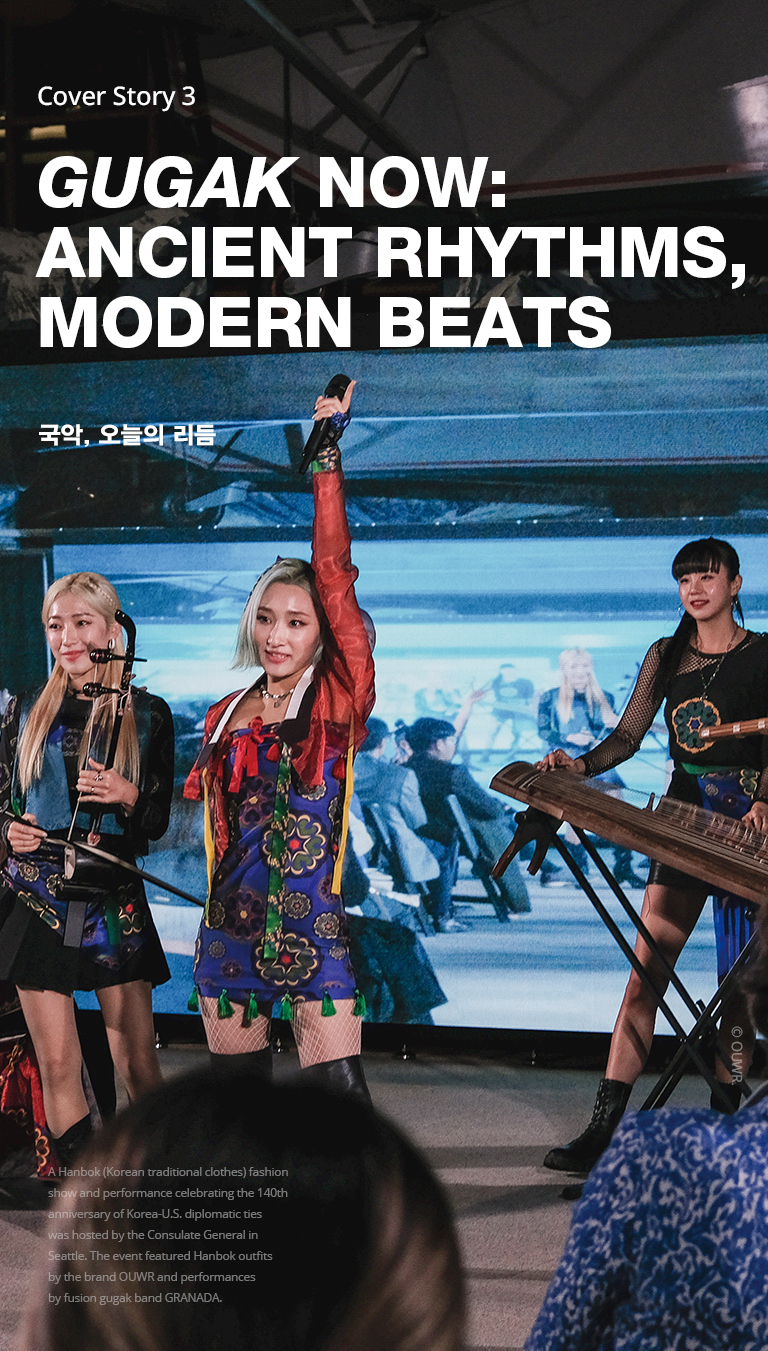
Korean music, with its unique resonance, has transformed in many ways with the times while firmly preserving its distinctive elements like deep emotion and unique scales. Gugak, which embodies a blend of familiarity and innovation, has today become a cornerstone of modern music, transcending traditional boundaries.
국악에는 한국 고유의 울림이 있다. 시대에 맞춰 다양한 모습으로 변화하면서도 깊은 정서, 독자적 음계와 같은 차별점은 굳건히 지켰다. 익숙함 속에 새로움, 새로움 속에 익숙함을 선보이는 국악은 전통을 넘어선 ‘오늘날의 문화’로서 자리 잡았다.
Writer. Jo In-sun
K-pop is thrilling music fans worldwide with its dazzling stage performances, addictive melodies and visually striking aesthetics. Upon closer inspection, you’ll notice traditional Korean instruments appearing in K-pop, along with variations of age-old folk melodies and familiar rhythmic patterns (jangdan). At the center of this evolution are traditional musicians making innovative musical attempts and collaborations.
The traditional music community, which once focused primarily on preservation, has undergone many trials and errors to reach this point of diverse experimentation and collaboration. Unlike Western musicians, traditional Korean musicians didn’t separate the roles of performer and composer. They actively communicated with audiences and absorbed trends through new sound explorations, developing innovative playing techniques and creating various performance configurations from solo and duo performances to chamber music and full orchestrations.
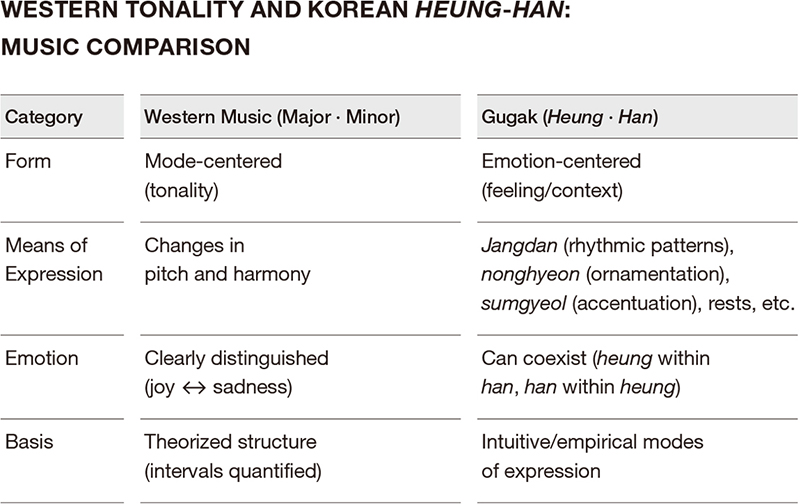
When digital sound layering technologies like effects processors and loop stations emerged in the 2000s, traditional musicians—skilled in performance, composition and arrangement—began experimenting with these technologies, ushering in a golden age for gugak. As they masterfully incorporated innovative recording and production techniques into traditional music, they gave birth to “new gugak” in completely different genres—new age, ethnic, jazz fusion, rock, trot and even EDM—all infused with traditional elements.
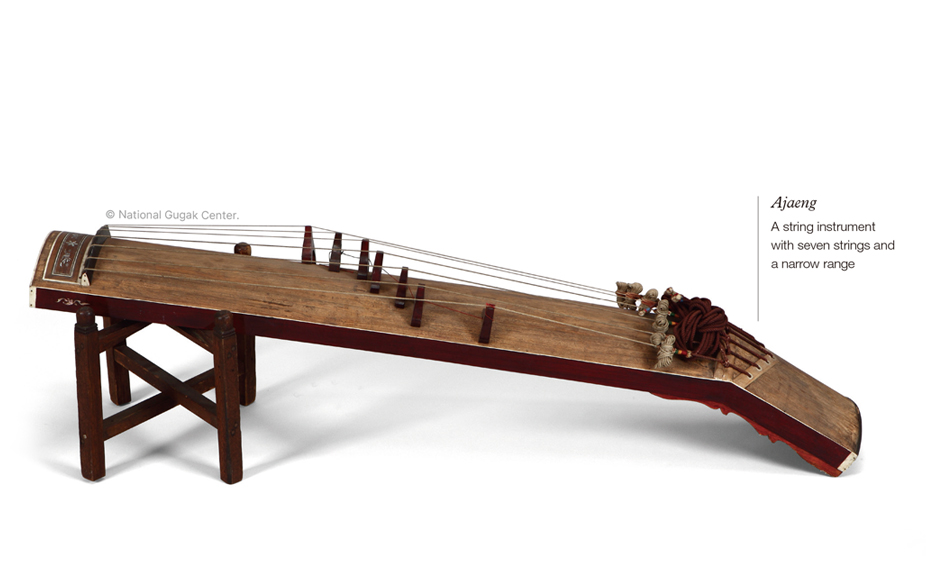
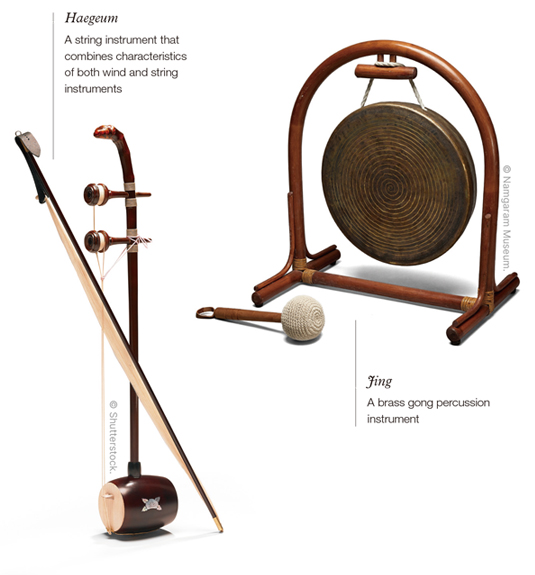
What makes gugak distinctly “Korean”? Traditional instruments add uniqueness to gugak. While functionally similar to Western instruments, they differ significantly in their expression and emotional delivery.
The ajaeng is a low-pitched string instrument resembling a cello. As a traditional bowed string instrument producing thick, low sounds, it serves a role similar to the Western cello. However, the sound created by scratching the strings with a bow is rough and resonant, directly expressing emotions. The haegeum is a two-stringed bowed instrument. Without a fingerboard, it determines pitch through subtle positioning using finger tension, creating a plaintive and fluid tone reminiscent of the human voice. In some ways, it’s an even more emotional and delicate string instrument than the violin.
The daegeum is Korea’s representative bamboo wind instrument, producing a wind-mixed tone through the vibration of a cheong (reed membrane). Though rougher than a Western flute, it directly reveals the player’s breath. The piri is a double-reed wind instrument similar to the oboe but with a much more intense and direct tone. In traditional ensembles, it leads the main melody and sets the emotional direction.
The janggu, an hourglass-shaped traditional percussion instrument, can simultaneously express high and low pitches. With differently shaped sticks, it can produce opposing rhythms within a single instrument, delicately handling the flow of emotions. The jing emphasizes transitional moments in compositions with deep, prolonged resonance, while the kkwaenggwari leads the overall performance’s pace and atmosphere with its sharp sound.
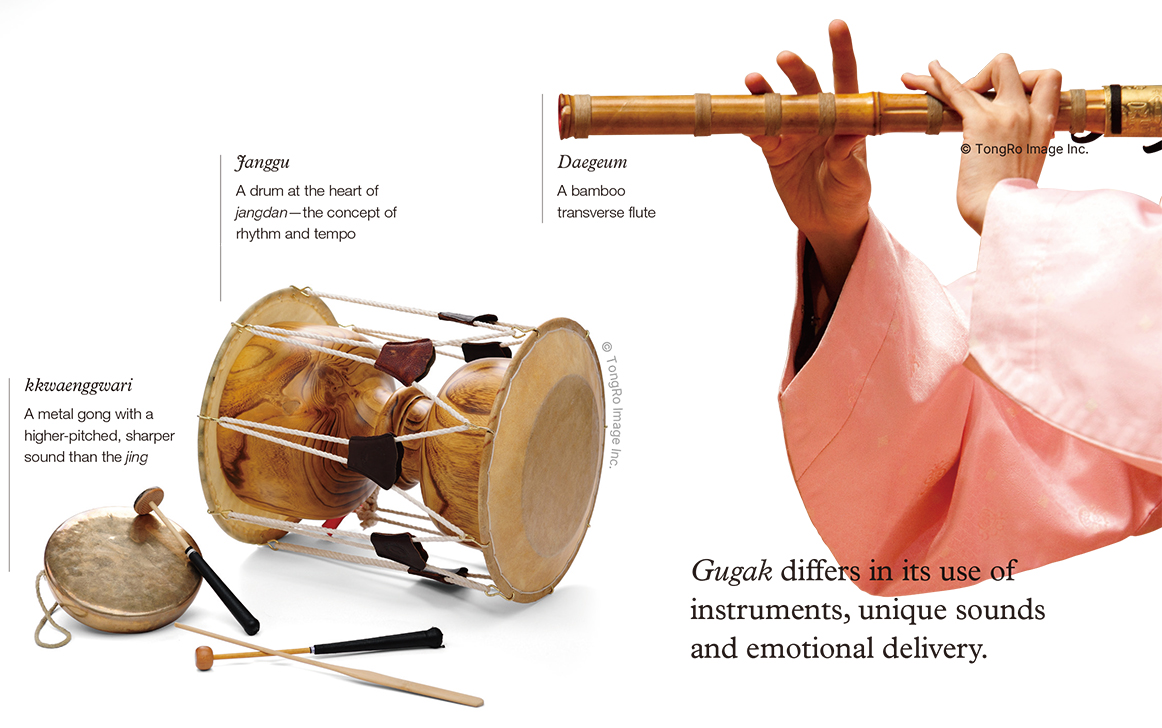
Beyond instrumental techniques and genre characteristics, Korean traditional music’s distinctive emotion and artistry also sets gugak apart. Gugak gives musical form to Korean life and emotions. The concepts conveyed in gugak include heung (excitement), sinmyeong (ecstasy) and han (sorrow). Energetic emotions like heung and sinmyeong are powerfully expressed in rhythm-centered performances like samulnori (traditional percussion music) and nongak (traditional farmers’ music). The deep sorrow of han is expressed in melody-centered pansori and folk songs.
A notable distinction between gugak and Western music is how gugak emphasizes “sentiment” or “emotion” in expressing compositions. Western music expresses pieces based on scales and tonality—recall the bright, hopeful feeling of major keys and the dark, lyrical feeling of minor keys. Western music categorizes musical expression and emotion quite clearly. Gugak conveys complex emotions beyond simple scales, expressing feelings that defy easy classification. It displays a wide spectrum of Korean emotions where heung and han intertwine.
Consider pansori as an example. Pansori is a genre where a single vocalist tells a story through hours of singing and speaking. In a pansori performance, the musicians and vocalist skillfully navigate between emotions of han and heung to draw audiences in. The vocalist, who leads the drama, adjusts the rhythm in real-time through coordination with gosu (the drummer). Sometimes they use aniri, speaking in a storytelling manner to convey emotions, while portraying various characters with a single voice. Even within one piece, they express rising dramatic structure by changing rhythms—from jinyangjo (the slowest jangdan—a steadily repeating 18/8 rhythmic cycle) to jungmori (medium-paced jangdan) to jajinmori (the fastest jangdan). Through these devices, the audience becomes more immersed. In pansori, audience and performer create a communal experience of han and heung together. The audience participates with chuimsae (verbal responses), and the vocalist sometimes changes the song accordingly. This performance style, shaped by audience interaction, is rare in other cultures.
Furthermore, gugak values emotional vibration over precise notes and the flow of breath over strict timing. Its philosophy of accepting silence and empty space as part of the music creates an aesthetic completely different from precisely calibrated Western music. It is at this point that Korea’s unique sensibility begins.
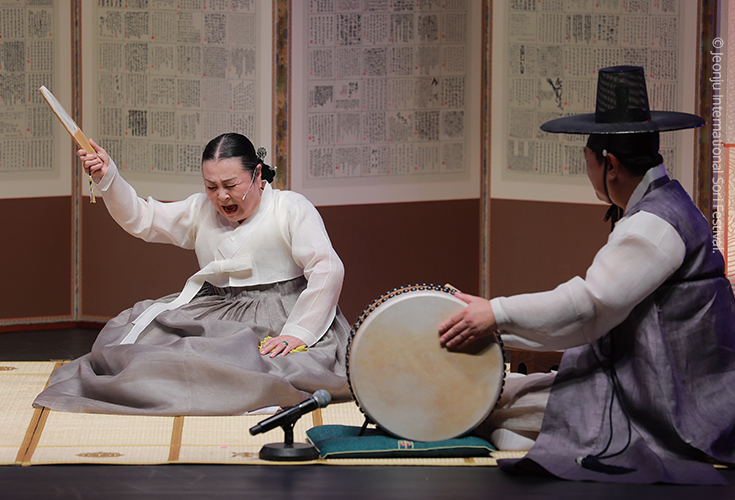 Pansori performance at the annual Jeonju International Sori Festival in Jeollabuk-do Province
Pansori performance at the annual Jeonju International Sori Festival in Jeollabuk-do Province Band GRANADA performs traditional Korean music while wearing Hanbok by the brand OUWR.
Band GRANADA performs traditional Korean music while wearing Hanbok by the brand OUWR.
Currently, efforts are underway to preserve and transmit gugak, as well as to fuse it with other genres and explore new interpretations. So gugak is not simply a reproduction of tradition. It remains influential, appearing in popular music, films, dramas, advertisements and games.
In any form, listening to gugak isn’t just experiencing tradition; it’s understanding the depth of Korean emotion, breath and aesthetics. Simply by listening and becoming immersed, one can experience the history and emotions of Korea in an instant. Therefore, countless fans worldwide who love Korea and audiences who appreciate music should now turn their ears to gugak—the root of Korean sound art and traditional Korean music.
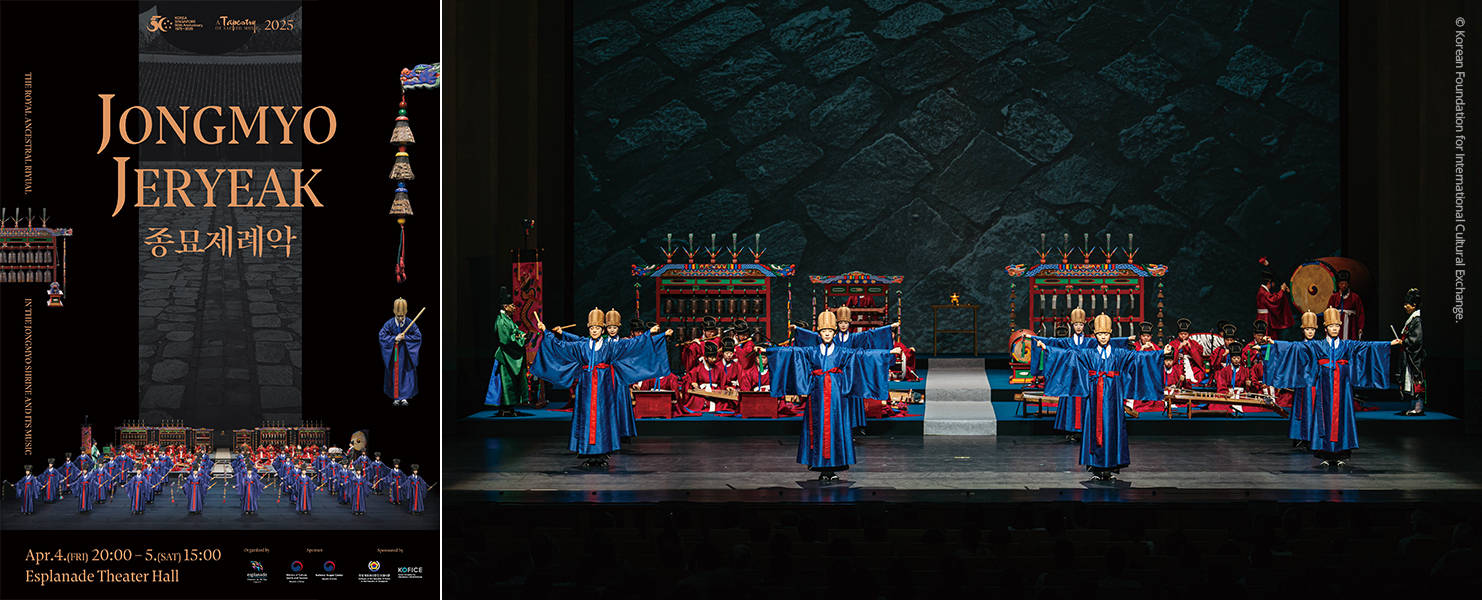 Jongmyo Jeryeak (Royal Ancestral Ritual Music of the Jongmyo Shrine) is performed to commemorate the 50th anniversary of diplomatic relations between Korea and Singapore at the Esplanade, Singapore’s national performing arts center.
Jongmyo Jeryeak (Royal Ancestral Ritual Music of the Jongmyo Shrine) is performed to commemorate the 50th anniversary of diplomatic relations between Korea and Singapore at the Esplanade, Singapore’s national performing arts center.
Writer. Jo In-sun
A traditional Korean music performer who studied ajaeng at the Korea National University of Arts, Jo is dedicated to promoting Korean traditional music both domestically and internationally by integrating traditional gugak with contemporary popular music.